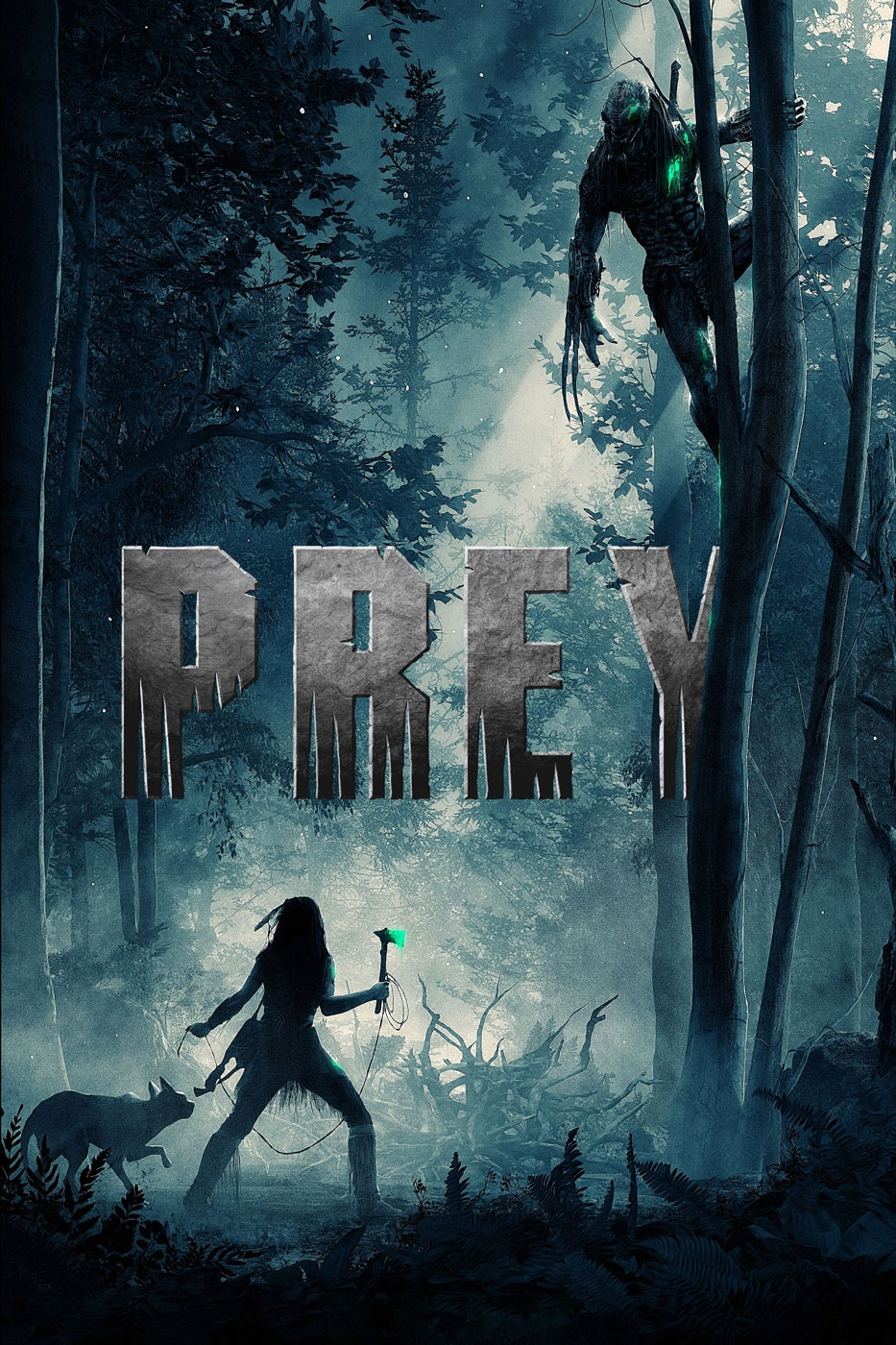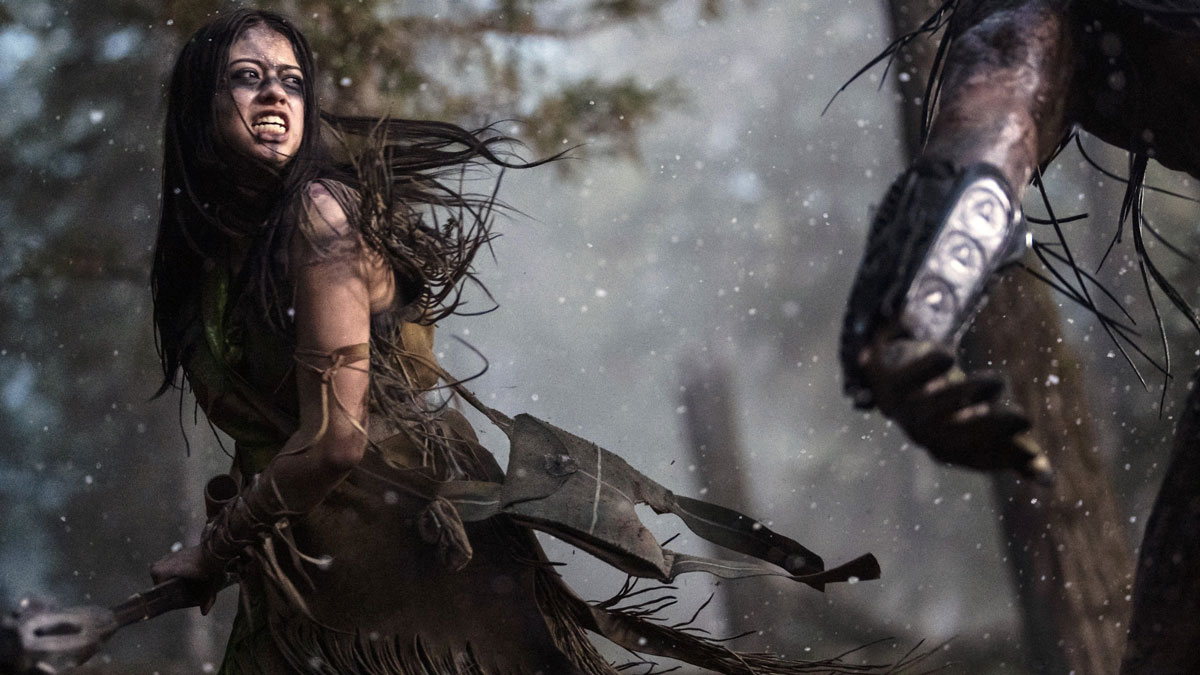

Filmkritiken
Prey
| erschienen | 05.08.2022 (Disney+) |
| Länge | 1 Stunde 40 Minuten |
| Genre | Action, Survival, Thriller, Natur |
| Regie | Dan Trachtenberg |
| Cast | Amber Midthunder, Dakota Beavers, Michelle Thrush, Stormee Kipp |
| Drehbuch | Patrick Aison, Dan Trachtenberg, Jim Thomas |
| Musik | Sarah Schachner |


Quelle: 20th Century Studios
Prey
8 / 10
September 1719. Naru, a young woman from the Comanche Tribe, crosses the forests of the Northern Great Plains with her dog Sarii in the search for vegetables and plants used for medical emergency. She secretly trains with a tomahawk given her feelings of dissatisfaction with her current task and her aspiration of becoming a warrior just like her brother Taabe (Dakota Beavers). As she tries to hunt down a full-grown moose, a thunder-esque rumble scares the animal and Naru tries to follow it. She aborts the hunt and arrives at a cliff a short while after where she starts observing the clouds. A meteor-resembling fire brightens up the grey sky and leaves her with worrying thoughts. Later on, she and Taabe join a rescue mission during the evening in which a fellow warrior has gone missing after a lion hunt. They can track him down, but Naru discovers a skinned snake along the return journey to the tents. An unknown enemy is breaching the Comanche’s hunting grounds and uses the skins of dead animals as trophies and serve as a warning for the warriors. She senses the upcoming danger and embarks on a lone journey with her dog to hunt down the forest’s newest dominator. Her true warrior trial against the unknown enemy with an unheard set of weapons is about to begin.
It should come as no surprise that not a small amount of people view John McTiernan’s Predator from 1987 as an action horror classic. It not only portrays heavily-trained, unforgiving mercenaries with overly cool one-liners fighting against a futuristic alien. It was also a showcase of combat-strategic minimalism combined with the synergy between Dutch and the Latin American jungle while addressing the traumata from Vietnam War veterans through horror. Now set in the 18th century, Dan Trachtenberg’s prequel Prey follows Naru’s encounters with an early version of the predator, combining a tribal coming-of-age story with heavy-handed action, horror and last, but not least, the obligatory battle for survival. He therefore recycles a lot of Predator’s key plot elements and lays them out like easy-to-follow breadcrumbs which make up for surprising throwbacks, a clever consideration of the historical context and a tense hunt split up into multiple stages. The Comanche dub gives the story an extra touch which is irritating at first with the moving lips, but enhances the atmosphere to a great extent as the plot thickens.
From the beginning, Trachtenberg presents beautiful distance shots of the Northern Great Plains, introducing the nature and the region’s wildlife. A parallel montage of imperfection and adaptation from both parties – akin to Matt Reeves’ The Batman – is subsequently presented to the viewer: Naru’s encapsulation from the warriors and her being stuck in a swamp and a struggling encounter with a bear later on, while the predator has a challenging climb towards the top of the food chain. This proto-version of the predator behaves different than his 1987 successor, actively discovering the nature with a visible, reckless lust for battle and competition, fascinated by the animals’ speed and power with the risk of destroying its advanced armor. It culminates in an epic shot of a blood-soaked predator lifting its animal opponent, the ultimate evidence of supremacy. Interestingly enough, its equipment has been adjusted in terms of technological innovation and makes room for two theories: Either the predator’s home planet already had a sneak peek at the Romans’ weaponry from many centuries ago – regarding an expansible shield and a spear – or their technology is simply not fully fleshed out yet while the Great Plains serve as a playground for the alien nation.
Prey thrives with the presence of the leading characters, especially Amber Midthunder playing the aspiring warrior Naru. She has seemingly no lack of self-confidence and possesses the experience of being a supporter for the male hunters, but the urge to encapsulate herself from the role model gets stronger day by day. Midthunder perfectly embodies this notion as well as her survival instinct and the menace originating from the unknown enemy. Given the constellation of a female Comanche and the predator’s hunting advantages in the 18th century, the film basically asks for being called out for implementing “wokeness” into the story. But Trachtenberg doesn’t just boil down the essence of Naru’s existence to the words of “I want to prove that a woman can hunt, too”. He smartly weaves in the tribal life during the New French colonial era across the Great Plains and eastern parts of North America.
The arrival of the French colony provides a nostalgic template for the story, making recalls to the muscled mercenaries and their early combat strategy. Similar limitations of their armory, brutal killings and desperate warfare become apparent over the course of their fight with the predator. The technological discrepancy is awe-inspiring to watch in contrast to the French’s frightened faces. Meanwhile, Naru and her brother Taabe are forced into a spectating role and provide smile-inducing fan service with the subsequent beginning of their tag team resistance following the predator’s onslaught. Dakota Beavers fulfills his debut acting role (!) with ease and strength. The combat minimalism makes a return, but in addition, Naru can utilize her tomahawk training, knowledge about herbalism and the terrain while being introduced to guns from the French occupant of a second colony. This results in a fascinating learning curve shaped by the reduction and evolution of hunting tactics.
In terms of the atmosphere, the cold, sunset color range harmonizes well with the mighty sound design. The predator’s clicking sounds and heavy footsteps, enhanced by timed bassdrums, help intensifying its dominant nature. Sarah Schachner’s videogame-inspired soundtrack outlines Naru’s emancipation arc with an almost too epic orchestra which slightly taints it. She shows a better tactfulness when it comes to the hunting sequences with a dark ambience characterized through howls, reverbed percussions, powerful drums and deep strings surrounding the hunt. The CGI of the animals negatively sticks out of the atmospheric scenery with synthetic fur and all too fluent movements from the bear, the wolf and the lion. It’s not as bad as in RRR, but there’s obvious room for optimization.
Technical issues aside, Dan Trachtenberg manages to capture the essence of John McTiernan’s iconic Predator from 1987 which is definitely not rooted in the muscle-packed delivery of one-liners. It’s the limitation of assault rifles and the minigun leading to the human integration into the nature and the strategy resulting from it. Prey begins where Predator ends: The primal version of hunting. We see a female warrior, who is already familiar with the territory, improving her fighting skills and her knowledge as the predator’s dominance plows its way through the forests. The coming-of-age story comes full circle, not just with Naru’s emancipation, but with her warning of the Comanche tribe against the approaching French colonies which prevents an ambush and saves the Tribe’s existence. The criticism of being “woke” in terms of a woman gaining the upper hand against a green predator, who is “dumb enough” to fall for her strategy, is mind-boggling. I’m sorry, but if we’re at this level of conversation in which a defeat caused by a woman is deemed as illogical and shameful, then what does that say about the mindset of those critics?
One would accuse this film of being revisionist in terms of the historical context, but the story’s simple, albeit predictable backbone of hunted and being hunted and the question about who the strongest entity of this territory is, makes the time frame fictionally flexible. In fact, Prey shares the spirit of the Far Cry series and makes the case for producing new adaptations set in any era of time, as long as the predator is granted enough presence. Even though the stakes are fairly reduced due to the Comanche’s strict role model, the story functions well enough to root for the captivating Amber Midthunder and her sidekicks Dakota Beaver and the charming dog Sarii. A different continent – a samurai adaptation has been rumored – and the link to the cultural or historical context could be interesting for the franchise, because in the end, it’s all about the hunt in the form of resistance against an unknown force threatening the territory and the human’s existence.
| Film | Prey |
| erschienen | 05.08.2022 (Disney+) |
| Länge | 1 Stunde 40 Minuten |
| Genre | Action, Survival, Thriller, Natur |
| Regie | Dan Trachtenberg |
| Cast | Amber Midthunder, Dakota Beavers, Michelle Thrush, Stormee Kipp |
| Drehbuch | Patrick Aison, Dan Trachtenberg, Jim Thomas |
| Musik | Sarah Schachner |


